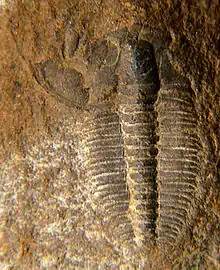| Olenus Temporal range: Upper Cambrian | |
|---|---|
 | |
| Olenus micrurus from Trawsfynydd, N Wales, right free cheek displaced to left and turned 150°, pygidium missing | |
| Scientific classification | |
| Kingdom: | |
| Phylum: | |
| Class: | |
| Order: | |
| Family: | |
| Genus: | Olenus |
| Species | |
| |
Olenus is a genus of Upper Cambrian ptychopariid trilobite.[4]
Distribution
Olenus can be found in the British Isles, India, Norway, Sweden, Denmark, Newfoundland, Texas, South Korea, and Australia.
- O. haimantensis occurs in the Middle Cambrian of India (upper part of the Parahio Formation, left bank of the Parahio/Barachu river, above the Moopa camping ground, Spiti).[3]
Ecology
Fossils of Olenus are commonly found in dark mudstones, which were deposited on the seafloor in environments with low oxygen levels. The very wide side lobes (or pleurae) are thought to have shielded extended gills, which would have helped the animal absorb the maximum amount of oxygen possible in such an environment. Evidence also suggests that Olenus and its relatives may have developed a symbiotic relationship with sulfate-reducing bacteria, either by feeding on them or by absorbing nutrients directly from them.
Taxonomy
Species previously assigned to Olenus
- O. forficula = Ceratopyge forficula
- O. pecten = Ctenopyge pecten
- O. punctatus = Asteropyge punctata
- O. thompsoni = Olenellus thompsoni
- O. zoppii = Dolerolenus zoppii
Species that may be confused with Olenus
- The bug Anchodelphax olenus
- The extant beetle Olenecamptus olenus.
- The fossil waterbeetle Limnoxenus olenus.
- The ant Polyrhachis olenus.
- The ladyslipper orchid Paphiopedilum "Olenus".
Description
Size: Up to 1.5 in (4 cm) long. It had up to 15 thoracic segments, with a narrow axis and wide pleurae.
References
- ↑ Hwang, H.-A.; Choi, D.K. (2005). "Heterochrony of the Late Cambrian olenid trilobites from the Machari Formation, Yeongwol, Korea: implications for biostratigraphy and intercontinental correlation". Geosciences Journal. 9 (2): 215–222. Bibcode:2005GescJ...9..215H. doi:10.1007/bf02910580. S2CID 140659760.
- ↑ Poulsen, C. (1956). "Proposed use of the Plenary Powers to secure the availability of the generic names Olenus Dalman [1827], and Paradoxides Brogniard [1822] (Class Trilobita) for use in the sense in which these names are customarily employed". Bulletin of Zoological Nomenclature. 12 (1). Archived from the original on 2014-01-11. Retrieved 2014-01-11.
- 1 2 Shah, S.K.; Parcha, S.K.; Raina, A.K. (1991). "Late Cambrian trilobites from Himalaya" (PDF). Journal of the Palaeontological Society of India. 36: 89–107.
- ↑ Bodil Wesenberg Lauridsen & Arne Thorshøj Nielsen (2005). "The Upper Cambrian trilobite Olenus at Andarum, Sweden: a case of iterative evolution?". Palaeontology. 48 (5): 1041–1056. Bibcode:2005Palgy..48.1041L. doi:10.1111/j.1475-4983.2005.00499.x.